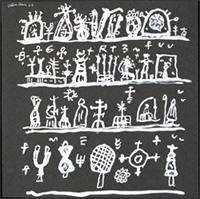Two exhibitions
dal 24/10/2003 al 25/1/2004
Segnalato da
24/10/2003
Two exhibitions
Tate St Ives, St Ives (Cornwall)
Alan Davie: Jingling Space at Tate St Ives is an exhibition that highlights the evolution of Davie's work from the 1930s to the present day, and offers fresh insights, particularly in relation to his interest in Surrealism. Partou Zia has been inspired by the prophetic writing and illustrations of William Blake, and her work explores a personal journey of self discovery.

Alan Davie
Jingling Space at Tate St Ives is an exhibition that highlights the evolution of Davie's work from the 1930s to the present day, and offers fresh insights, particularly in relation to his interest in Surrealism.
In 1941 Davie won a travel scholarship, which he took up after completing war service. He travelled around Europe, where his work attracted the attention of the influential collector Peggy Guggenheim. On return to Britain, Davie's knowledge of European artists contributed to the development of his own work. In 1956 he exhibited in New York where he met Jackson Pollock, Franz Kline, Willem De Kooning, Robert Motherwell and Mark Rothko. Davie has continued to travel widely and exhibits extensively in Europe and the United States.
Early works on show at Tate St Ives include The Teapot 1938 and Landscape with a Bridge 1945. From the 1950s Davie freed himself from the conventions of picture making to create works that allowed the liberation of subconscious ideas inspired by Surrealism. Davie is also a jazz musician and often uses dynamic dancing forms in his large scale colourful works. Jingling Space 1950, from which the title of the exhibition is taken, is executed in an entirely spontaneous way. This work has direct musical connotations, which Davie has referred to in terms of strings, bells and percussion.
Much of Davie's work includes elements inspired by ancient, ethnic and religious cultures. Significant works exhibited at Tate St Ives include Creation of Man 1957, Kaleidoscope for a Parrot 1960, Holyman's Bird Meditation 1960 and Lush Life 1961. The chess board, wheel, serpent, moon and birds are amongst an array of frequently appearing motifs in Davie's later paintings, including Fairy Tree 1971 and Flight of the Flieblies 1973. There will also be a display of new works made in Cornwall, where Davie has used white gouache on black paper to evoke a primal language of stark symbolic imagery.
Davie has a strong connection with Cornwall, where he has had a studio since the late 1950s, and through his friendship with a number of St Ives artists. A major work created at that time, Patrick's Delight 1960, was a tribute to the artist Patrick Heron and will be on show. However, Davie's paintings generally have greater affinity with the Surrealists and painters of the Cobra group. To complement his exhibition at Tate St Ives, a group of works from the Tate Collection by Max Ernst, Paul Klee, Joan Miro, Pablo Picasso, Henri Matisse and Jackson Pollock will be shown.
Image: Alan Davie, Journey of the Signs, 2003
© Alan Davie
__________
Partou Zia
This ambitious scheme will have a lasting legacy in terms of the support that Tate St Ives offers each artist. Using one of the historic Porthmeor Studios in St Ives, previously occupied by Borlase Smart, Ben Nicholson and Patrick Heron, each artist will have the opportunity to raise the scale of ambition in their work.
The pilot year has involved Partou Zia who has been offered an exhibition at Tate St Ives alongside Alan Davie (25 October 2003 - 25 January 2004). Persian born Zia has lived in Newlyn, Cornwall since 1993, and during her residency at Porthmeor Studios she was invited to respond to the work of an artist represented in the Tate Collection.
Zia has been inspired by the prophetic writing and illustrations of William Blake, and her work explores a personal journey of self discovery. Through these vibrant, painterly canvases, she draws the viewer into the poetics of her world. The colour and depth of these symbolic works unfold in a cultural, spiritual and philosophical inquiry as Zia reconciles a sense of her isolated existence as an Asian female artist practising in South West England.
In response to Blake's visionary language, Zia's evocative paintings offer relevance in relation to the human condition. The work of William Blake will also be on show at Tate St Ives from 25 October 2003 - 25 January 2004.
Each artists' residency will be accompanied by a publication, including an essay by a writer based in Cornwall. Dr Virginia Button will write the first essay on Partou Zia's work.
Tate St Ives
Porthmeor Beach
London



